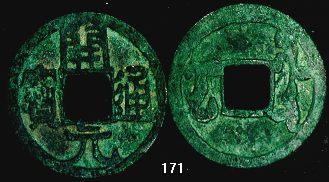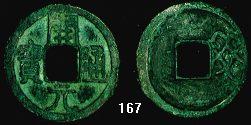Тюргеши - Согд, Чач, Фергана
Ca. 600 - 1000 AD
Turgesh/Arslanid's coins - http://www.charm.ru/coins/misc/turgeshcashwithrunas.shtml
COINS OF CENTRAL ASIA - http://www.sogdcoins.narod.ru/english/semirechie/coins.html
Turgis Coin - http://www.henan-china.com/ChinaInfo/xinjiangyishu/Brone/136e.htm
- http://www.coinet.net/sk20.htm
Larissa Baratowa, Tashkent: Old Turkic Coins of Central Asia
http://www.onsnumis.org/news/jena99.shtml
: Un-Iconographic Types The Old Turkic coins follow the principal design of the Chinese cash: a square hole in the center with inscriptions at its sides. The definition ‘Old Turkic’ derives from the names and titles which appear in the legends. These coins can be divided into classes, groups and types. The following picture emerges if we take into consideration the topography and stratigraphy of finds:
I. - Coins of the „Turgesh circle": groups A, B, C - Semirechye (=Jety-Su), from the end of the 7th century AD.
II. - Turgesh coins: group A - consisting of seven types - Semirechye - after 730s.
III. - Coins with Turkic names and titles: group A, B, C, D - some cities of Sogd, Chach, Fergana and Semirechye - from the end of the 7th to the middle of the 8th century.
IV. - Coins of anonymous Kagans: groups A, B, C, D - Sogd, Chach, Fergana - around the middle of the 8th century.
V - „Proto-Karakhanid" coins: group A - Semirechye - the 9th - 10th century.
The script and language of the inscriptions are Sogdian, with the exception of the „Proto-Karakhanid" coins, which carry Kufic legends. The appearance of coins with inscriptions on both sides (one mentions the Turgesh Kagan and the other referring to the local Sogdian ruler) within ‘Class I’ reflects the political dependance of the Sogdian principalities on the Turgesh Kagans. This led Mrs. Baratova to suggest that the Turgesh coins, which are known from finds throughout Central Asia, were produced under the influence of those cities.
Some Turgesh coin-types were obviously issued by representatives of the Karluk Dynasty, which came to power in Semirechye after 766 AD.
The coins of ‘Class III’ were cast by Old Turkic rulers in Sogd and Chach. Mrs. Baratova reported on the Turkish rulers according to the Chinese chronicles.
An important question remains: who was responsible for the issue of the anonymous coins of ‘Class IV’ with the title ‘Kagan’? The answer to this question can be found if one takes into consideration the distribution of finds as well as the traditions of the Türkic statehood and the general background provided by Central Asian history. It can be assumed that the coins of ‘Class IV’ were issued by Turkic sovereigns, which ruled for a short time over certain areas of Sogd and Chach. The title g’g’n (Kagan) was used as a counterpart to the Sogdian title xw’b (Yagbu = ‘Western Viceroy’), which was common on the coins of Central Asia from the 6th to the 8th century. The relatively low number of Turkic coins found in Sogd, Chach and Fergana is due to the chronological limits of this coinage - it was terminated by the Arab conquest of Mawarannahr and the consequent introduction of new kinds of coins. In Semirechye, however, the issue of Old Turkic coins continues into the 9th to 10th century developing into the transitional ‘Proto-Karakhanid’ coinage with Chinese fabric and Kufic inscriptions.
Выдержка из работы С.Яценко показывает династическую или государственную или Чачскую тамгу на Сарматских памятниках ок. 150 - 250 н.э. и на Чачских монетах пре-Тюргешского времени (датировка монет отсутствует). Для понимания отношения Кангар - Сармат, должно быть учтено происхождение тамг на Сарматских памятниках.
W. Ukraine Sarmats - Kangars
| N.Pontic Sarmats ca 150 - 250 AD | Chach |
| Fig. 6/55 | Fig. 29/32 |
|
|
|
Respective Chach Coins
http://www.kroraina.com/ca/c_chach.html
 |
 |
 |
Извиняюсь за неполный техт, я не намерен иметь Японский фонт на сайте.
http://www1.u-netsurf.ne.jp/~sirakawa/C014.htm => Wayback Machine
| Baga Turgish Qaghan pny | |
| ~~~ twrkys kagan pny | Godlike Türgesh kagan's coin' |
| ~~~ twrkys kagan pny | Fen of king Turgesh's kagan |
| ~~~ | Heavenly Turgis Khanate Coin |
| ~~~ | (Sulu Qaghan) |
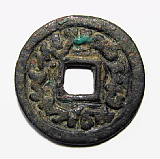 |
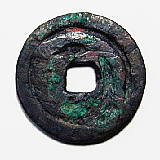 |
24.8mm 4.7g |


По: Джим Фарр
http://www.islamiccoinsgroup.50g.com/assikka21/mahdi149.htm
Древний Чач, современный Ташкент в Узбекистане, занимал видное место по торговому пути известному как Шелковая Дорога. Самая ранняя известная чеканка из Чача состоит из местных медных монет с конца 3-ьего столетия Н.Э. (Frye, 1996). Пред-исламская чеканка достигла зенита в 4-м и 5-м столетиях, с монетами, показывающими местную тамгу и монетный двор Чачи, написанный по Арамейски (Rtveladze, 1998). Более поздние медные монеты из Чача безписмены, и к раннему 7-ому столетию, чеканка стала децентрализованной, выпущенная правителями полуавтономных доминионов в пределах территории Чачи (Rtveladze, 1982, в Zeimal, 1994). Серебряная чеканка состояла из Букархудатской драхмы, некоторые из которой были отчеканены в районе Чачи (Davidovich, 1979).
Монеты ниже скопированы с http://www.grifterrec.com/coins/centralasia/centralasia2.html
|
Около 500 - 600 Н.Э. (?) Король Чачи/Асбар(?), AE Драхма(?) Тамга в центре, Согдианская (?) надпись вокруг |
Блюдо с надписью с именем сына Атиллы Диггизиха
Диггизиха и тамга в его надписи |
||
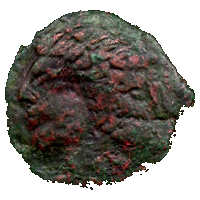 |
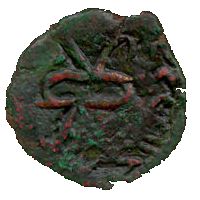 |
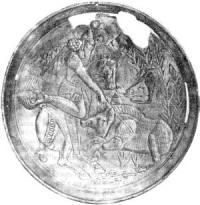 |
|
|
Около 650 - 750 Н.Э. (?)
Король Тарнавч(?) |
Тамга | ||
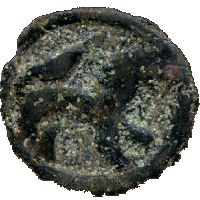 |
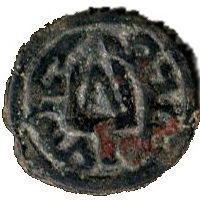 |
 |
|
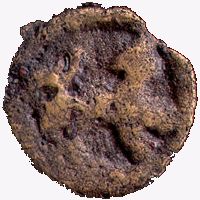 |
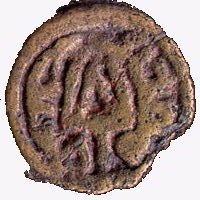 |
 |
|
Около 650 - 750 Н.Э. (?)
Король Чачи, AE Drachm (?)
Тамга в центре; Согдианская (?) надпись вокруг
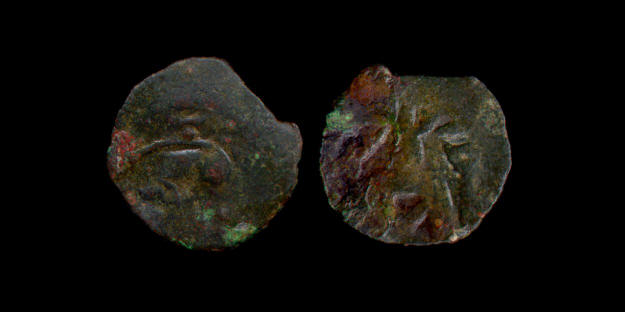
Около 650 - 750 Н.Э. (?)
Король Чачи/Владение Фарнката, AE Драхма(?)
Тамга в центре; Согдианская (?) надпись вокругТамга
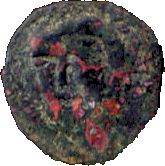
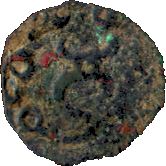
![]()
Первые набеги мусульманскими Арабами в Чач произошли в 713-714 Н.Э./АХ 94-95 под лидерством Кутайба бин Мусульманин (Mayer, 1998). Самые ранние Исламские монеты, в настоящее время опубликованные из Чачи - серебряный дирхам (возможно уникальный) из Мадинат Аль-Шаш в 803-м, дирхамы из Мадан Аль-Шаш в 808-м, и дирхам из Чачи (Аль-Шаш) в 814-м (Mayer, 1998). Неизвестно, являются ли Аль-Шаш, Madinat Аль-Шаш и Мадан Аль-Шаш тем же самым монетным двором, но кажется разумным, что нет. Zambaur (1968) перечисляет дирхамы, выпущенные в Аль-Шаш в 782-м и 785-м, но сам он сомневался относительно существования ехемпляра от 785-го, и Mayer (1998) сообщил, что 782-го ехемпляр также сомнителен. Mayer заключил, что самая ранняя исламская монета, быпущенная в Чаче была датирована 803-м.
Sogdian Kai Yuans
T.D. Yih and J. de Kreek lectured at the Dutch 1994-ONS meeting
The coins below are copied from http://www.charm.ru/coins/misc/Soghdian-kaiyuan.shtml
 |
 |
 |
 |
 |
|
 |
 |
|
 |
 |
|
 |
 |
 |
 |
 |
|
 |
 |
|
 |
